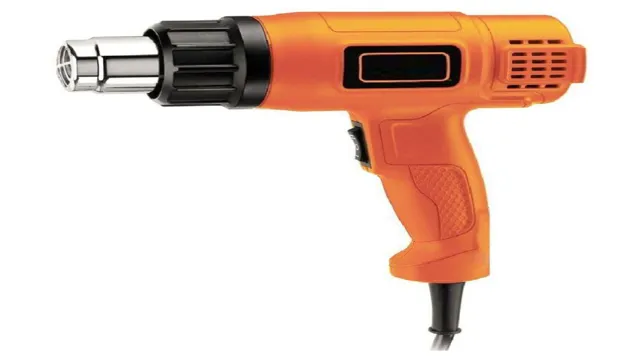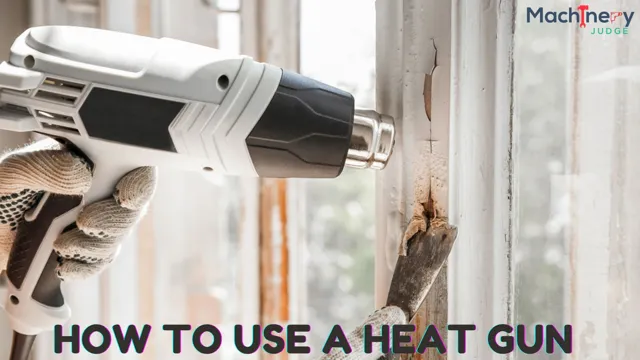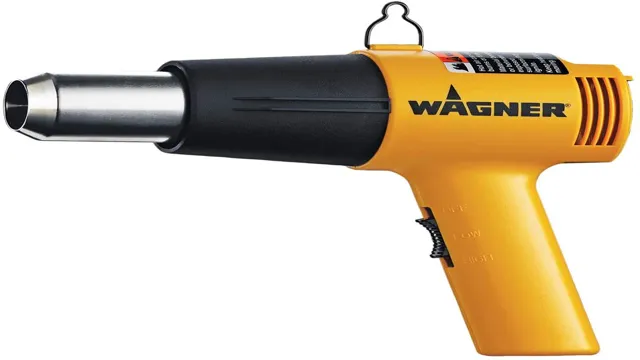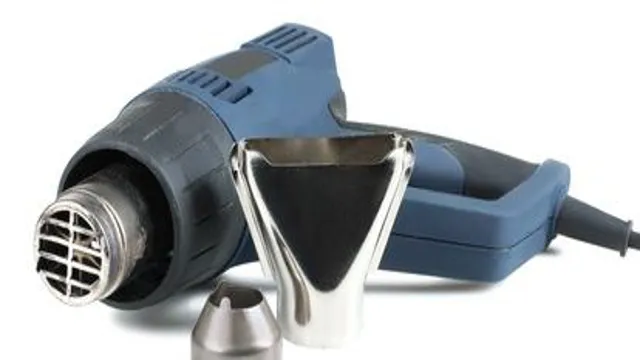Can You Use a Heat Gun to Dry Paint? A Comprehensive Guide
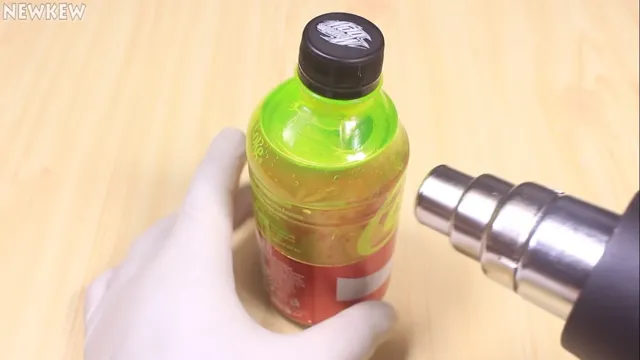
If you are a DIY enthusiast or a professional painter, you know that drying paint can be a pain. Even though air drying is the most common way of drying paint, sometimes it can take longer than expected, especially in humid weather or cold temperatures. But worry no more! By using a heat gun, you can speed up the drying process and get that beautiful finish you’re after.
Using a heat gun to dry paint is a simple technique that requires some precautions to avoid damaging the surface or causing a fire hazard. In this blog post, we will guide you through the process of using a heat gun to dry paint safely and effectively. We will also provide you with some handy tips to make your paint job a success.
So sit tight, grab your heat gun and get ready to take your painting game to the next level!
Understanding Heat Guns
If you’re wondering whether you can use a heat gun to dry paint, the answer is yes, but you need to be careful. A heat gun can help dry paint quickly, but if used incorrectly, it can also cause damage. It’s important to make sure you use the right setting on the heat gun, as setting it too high can cause the paint to bubble and peel.
Keep the heat gun moving back and forth over the surface of the paint, and don’t hold it too close to the surface. You should also make sure you wear protective gear like gloves and safety glasses to protect yourself. So, while a heat gun can be a useful tool for drying paint, it’s important to use it correctly to avoid any mishaps.
How They Work
Heat guns are versatile handheld tools that can generate gusts of hot air that can be directed onto a specific area to impart heat energy, making them ideal for a wide range of applications. These tools operate on either electricity or natural gas and have a range of temperature settings, depending on the specific use-case. They feature a barrel-shaped nozzle to direct hot air onto the target object.
The heat gun’s nozzle can also be adjusted to various angles to suit what the user is working on. Heat guns have a broad range of uses, from stripping paint to bending plastic pipes, and they are particularly useful for drying or curing. Additionally, heat guns enable users to shrink wrap, anneal glass, thaw frozen pipes, and even remove stickers.
Overall, heat guns provide an invaluable tool that makes time-intensive tasks less arduous and easier to complete.
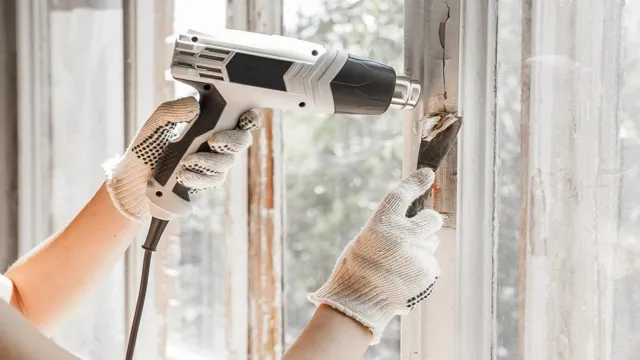
Types of Heat Guns Available
Heat guns are a versatile tool with a wide range of applications. When it comes to heat guns, there are many types available in the market. This makes choosing the right heat gun for your needs a bit challenging.
However, understanding heat guns helps to make an informed decision. It is essential to know that heat guns come in different sizes, shapes, and designs, and they also produce varying temperatures and airflow. For instance, some heat guns are built to produce low temperatures suitable for delicate tasks, while others are designed to generate high temperatures perfect for heavy-duty tasks.
By knowing the different types of heat guns available, you can choose the appropriate tool that aligns with your specific needs. Some of the popular types of heat guns include cordless, electric, gas-powered, and infrared heat guns. It is vital to consider factors such as the task to be performed, budget, and the features of each heat gun when choosing the perfect heat gun for your needs.
Paint Drying Process
If you’re wondering whether you can use a heat gun to dry paint, the answer is yes, but with some caveats. Using a heat gun is a quick and efficient way to dry paint, but it’s important to use it carefully to avoid damaging your paint job or even causing a fire. Make sure that you’re using a heat gun designed for paint drying and that you keep it moving to prevent overheating any one spot.
A good rule of thumb is to hold the heat gun no closer than 6 inches from the surface and to continuously move it around in a circular motion. Also, avoid using a heat gun on heat-sensitive surfaces and consider wearing proper protective gear like gloves, goggles, and a mask. While using a heat gun for paint drying can be a time-saver, it’s important to take proper precautions to avoid any accidents or damage to your project.
So, go ahead and use a heat gun, but use it with care.
Factors Affecting Paint Drying Time
The paint drying process can be affected by a variety of factors, such as temperature, humidity, and the type of paint being used. Generally, when paint is applied, solvents begin to evaporate, leaving behind the binding agents that hold the pigment together. As these agents harden, the paint begins to dry.
However, this process can be slowed down by high humidity, which increases the amount of time it takes for solvents to evaporate. Similarly, cold temperatures can cause the binding agents to harden more slowly, resulting in a longer drying time. It’s important to follow the manufacturer’s instructions when it comes to drying times, as different types of paint can have varying requirements.
Overall, understanding the factors that affect paint drying can help ensure a successful paint job and prevent frustration with a longer than expected drying time.
Avoiding Common Drying Problems
When it comes to painting, drying time is crucial as it can make or break your project. The paint drying process generally involves two stages: evaporation and oxidation. Evaporation happens when the solvent or water in the paint evaporates, leaving behind the solids.
Oxidation is when the paint reacts with oxygen in the air, causing it to dry and harden. It is important to ensure that there is adequate ventilation and airflow in the area where you are painting, as this can speed up the drying process. A common mistake is to try to speed up the process by using heat sources such as hair dryers or heaters.
This can cause the paint to dry too quickly, leading to cracking and bubbling. On the other hand, if the area is too cold or humid, the drying time may be significantly slowed down. Proper temperature and humidity control is crucial to a successful paint job.
Remember, patience is key when it comes to painting and allowing sufficient drying time will ensure a smooth, long-lasting finish.
Using a Heat Gun for Paint Drying
Yes, you can certainly use a heat gun to dry paint. In fact, it is a quick and effective way to speed up the drying process. A heat gun blows hot air onto a surface, which can help evaporate moisture in the paint and speed up the curing time.
However, it is important to use caution when using a heat gun, as too much heat can cause the paint to bubble or crack. It is best to hold the heat gun at a distance and use a low setting to avoid damaging the surface or the paint. Additionally, it is important to make sure the surface is completely dry and that there are no flammable materials nearby when using a heat gun.
Overall, using a heat gun can be a great way to expedite the paint drying process, but it should be used carefully and with proper precautions in place.
When to Use a Heat Gun
When it comes to painting, one of the most frustrating things is waiting for the paint to dry. It can take hours, even days, depending on the type of paint used and the temperature and humidity in the room. That’s where a heat gun can come in handy.
Using a heat gun for paint drying can speed up the process significantly. Simply aim the heat gun at the painted surface and move it back and forth, being careful not to hold it in one spot for too long, which can cause the paint to bubble and blister. The heat from the gun helps the paint to dry faster, allowing you to move on with your project more quickly.
However, it’s important to note that a heat gun should only be used on certain types of paint, such as latex and enamel, and not on surfaces that are easily damaged by heat, such as plastic. With proper use, a heat gun can be a valuable tool for any DIY enthusiast or professional painter.
Precautions to Take
If you’re using a heat gun for paint drying, there are a few precautions you should take to ensure your safety and the best results possible. First and foremost, always wear protective eyewear and gloves to prevent burns. Additionally, make sure the area you’re working in is well-ventilated to prevent fumes from building up and causing harm.
When using the heat gun, keep it moving constantly to prevent scorching the paint or other materials. It’s also important to keep the gun at a safe distance from the surface you’re drying, as applying too much heat to one area for too long can cause bubbling or cracking. With these simple precautions in mind, you can safely and effectively use a heat gun for paint drying and achieve professional-quality results.
How to Use a Heat Gun to Dry Paint Safely
Using a heat gun for paint drying can speed up the process and provide a professional-looking finish, but it is important to approach it safely. Before starting, make sure the surface is clean and free of debris. Keep the heat gun moving constantly to prevent scorching and avoid aiming the gun too closely at one spot.
Holding the gun too close to the surface may also cause the paint to bubble or crack. Take frequent breaks to avoid heating the surface for too long and causing permanent damage. Additionally, always wear protective gear such as gloves and eye protection to prevent burns and eye damage.
Remember to keep a safe distance from the heated area and always work in a well-ventilated space to prevent fume inhalation. By following these safety precautions, you can use a heat gun to dry paint effectively and efficiently.
Conclusion
In conclusion, while a heat gun may seem like a quick and efficient way to dry paint, it’s important to remember that patience is a virtue when it comes to achieving a flawless finish. Using excessive heat can cause the paint to bubble, crack, and even peel off, leaving you with an unsightly mess. So, next time you’re tempted to reach for a heat gun to speed up the drying process, resist the urge and let nature take its course.
Because when it comes to painting, slow and steady wins the race (and prevents any unfortunate mishaps along the way).
FAQs
What is a heat gun and how does it work?
A heat gun is a tool that blows hot air out of a nozzle, usually used for stripping paint or thawing pipes. It works by converting electrical energy into heat energy.
Is it safe to use a heat gun to dry paint?
Yes, a heat gun can be used to dry paint. However, caution should be taken as the heat can cause the paint to bubble or even ignite if held too close or for too long.
What is the best temperature to use a heat gun for drying paint?
The best temperature to use a heat gun for drying paint will depend on the type of paint used. It is recommended to start with a low temperature and gradually increase until the desired level of dryness is achieved.
Can a heat gun be used on all types of paint?
No, a heat gun should not be used on all types of paint. It can damage or warp certain types, such as latex or other water-based paints.
How long does it take to dry paint with a heat gun?
The time it takes to dry paint with a heat gun will depend on several factors, such as the paint type, thickness, and the heat level used. It can take anywhere from a few seconds to several minutes.
What safety precautions should be taken when using a heat gun to dry paint?
It is essential to wear protective gloves and goggles when using a heat gun. Keep the heat gun away from flammable materials and be cautious not to hold the gun too close to the surface being dried.
Can a heat gun be used on wet wood to dry it out?
Yes, a heat gun can be used on wet wood to dry it out. However, it is essential to take safety precautions and avoid overheating the wood to prevent it from cracking or warping.

